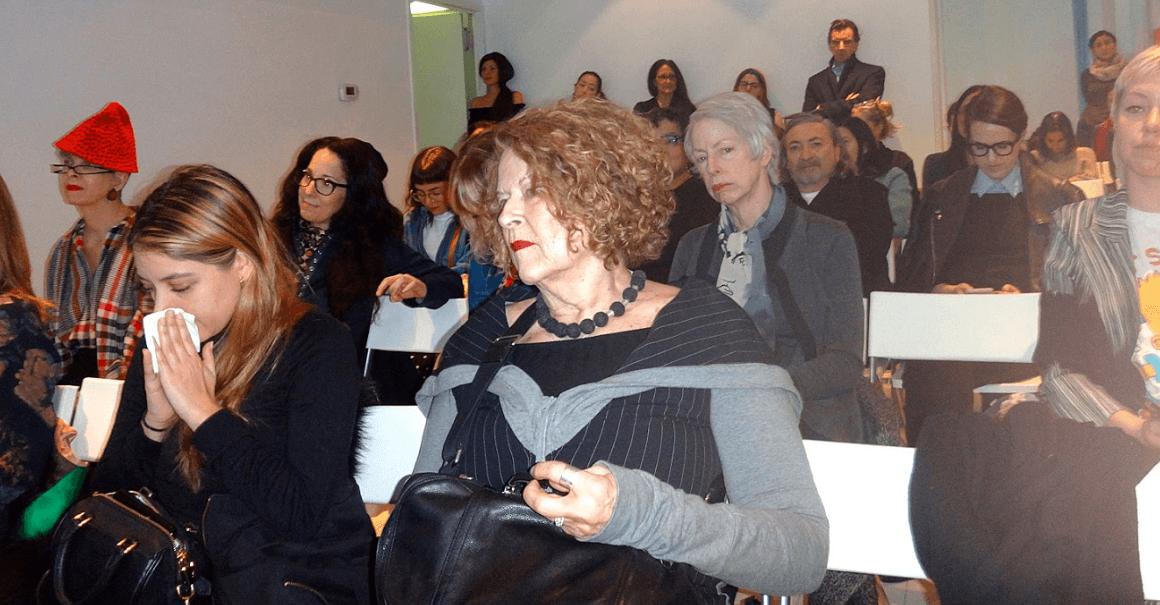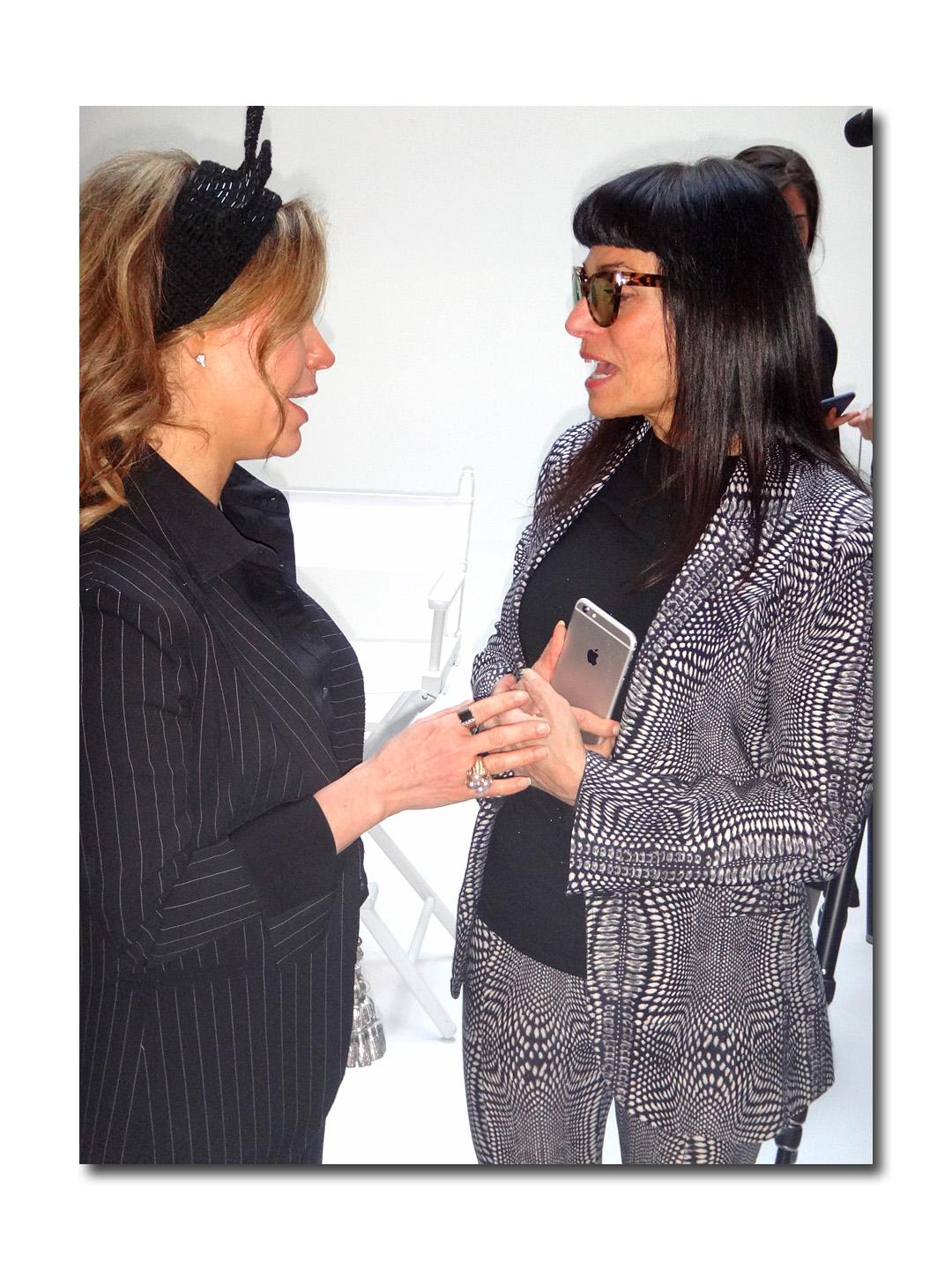 |
| Norma Kamali All photos Laurel Marcus |
Like a lot of women, Norma Kamali felt the need to pare down her possessions when she turned 50. Like a lot of designers she had kept warehoused archives of her vintage samples dating back to 1967, the year she began her business. I remember a little over a year ago having to miss one of these sales however, life is all about second chances — another warehouse of Kamali treasures was recently discovered, prompting not only a sale but a talk by the legend herself which I attended yesterday in her store/showroom on West 56th Street. See her website at normakamali.com/.
 |
| Audience |
In an all white room used for photo shoots, about 80 NK enthusiasts, many dressed in vintage Kamali pieces, listened raptly as Norma explained that many designers, artists and regular people have collected her vintage pieces as inspo. “I don’t look back, I look forward but many of these pieces are timeless. The sleeping bag coat, a style from 35-40 years ago still works. In this collection, there are some really beautiful pieces that I’d like to keep for myself. They have so much a part of my soul, I can’t tell you,” she said.
 |
| A staff member |
On inspiration: “Any designer can tell you that doing four collections a year means you’re always thinking. I think about things that excite me. I get that 3 A.M. idea and I’ve got to write it down right away. These ideas don’t feel like they’re coming from me — someone’s gifting them to me. I asked a psychic about it once because I feel like I’m cheating and she said ‘they are.’ That was like my confession.”
 |
| A wall of accessories at the sale |
On her early influences: “In school I wanted to be a painter. I studied Michelangelo and Nureyev since he reminded me of the statue of David. I studied form, physical form and movement. I did not think I would go into fashion design. I got a scholarship to FIT and studied fashion illustration but couldn’t get the “Mad Men” thing together (the hat, the gloves, the suit, the girdle). I had Antonio Lopez’s instructor who thought my work was good. If she thinks I’m ok, maybe I am.”
 |
| Fans |
On her first bad experience in the garment center: “My mother said get a job or I’m going to put a lock on the refrigerator. I walked in all excited to show my portfolio and this guy had his feet up on the desk, eating a tuna sandwich. He said to put the portfolio down and then asked me to turn around. White noise, what do I do?” Apparently she turned then ran out of the room and decided to work in the travel industry where she was first introduced to the Univac computer and to London.
On London in the mid ’60s: “I stayed in a boarding house on Kings Road. Everything was gray outside but the color, music, films, people, environment gave me the chills. It was me, understanding who I was through the revelation. I came back to New York and opened a basement store on 53rd St. with clothes I brought back from London. Then I decided I would try to make the pattern myself.”
On generational shifts in fashion and the women’s movement: “In every decade there’s a new influence — the bodies are different. In the ’60s Twiggy had no muscle tone. In the ’70s through the Who Am I? revolution, I learned that I could run a business. Women had no voice, they expected men to take care of everything. I have letters thanking me for showing women that they could do this — make it on their own. I needed to make sure women felt good about themselves. We have an astounding power to change the world when we feel good in what we wear and when we take our clothes off through health and fitness.”
On being touched by her customers: “I love the stories of what you wore, where you wore it and what happened. Women tell me these stories about the clothes as a marker in their lives. It’s very impactful for me. I am living my dream.” And working on a new book due out around the end of the year.
 |
| The original 1976 diaper swimsuit |
On the influence of dance in her work: Norma spoke of costuming “The Wiz” and “Come Fly With Me” as well as her work with Lycra for clothing worn to dance at Studio 54. “I worked with circus fabric and girdle fabric for dance, movement, swimwear. I had invented a swimsuit out of one piece of fabric that you wrapped around called the diaper swimsuit. One of the most creative people, Victor Hugo (design director for Halston) had the diaper suit on the cover of TIME magazine (which Halston was credited for). In order to make it up to me he invited me to Halston’s house while Halston was away. I didn’t want to go but finally I agreed. He told me to sit down on this ottoman and he dropped a parachute on my head. ‘I know you can do something with this’ he said. I made the jumpsuit that he wore dancing every night. I dyed them every color. Diana Vreeland put then in the Met Museum exhibit of clothing from living designers.”
On Karaoke nights: “Singing is important as part of wellness. Laughing, singing, dancing are so therapeutic.”
On the future of retailing/merchandising: During the Q & A someone mentioned that her shop resembles a gallery with mannequins lined up to greet you when you walk in. Norma dislikes clothing on hangers and wants as many mannequins as possible. The merchandise is color coded and completely computer integrated — she wants her customer to be like her and order everything online. “Try on swimsuits at home. I don’t want you to ask women to get naked here where they’re not comfortable. This is the generation that buys everything online. We’re all in this big fantastic transition. This revolution is beyond the ’60s in megawatts. The Millennials and Gen Z — I totally love the Gen Z’s. We’re all lucky to be a part of it. We have to be a part of it.”
Lastly, Norma’s long time friend Nancy gave a testimonial to a staple in her wardrobe, an original sleeping bag coat: “Men have come and gone but the coat has stayed.”




I have a plastic black Norma Kamali hanger from the 70s. I wish I still had all the clothes that I bought back then, I loved her style back then, and I have not seen her clothing in a long time in any stores.
Wondering if this hanger has any value today.